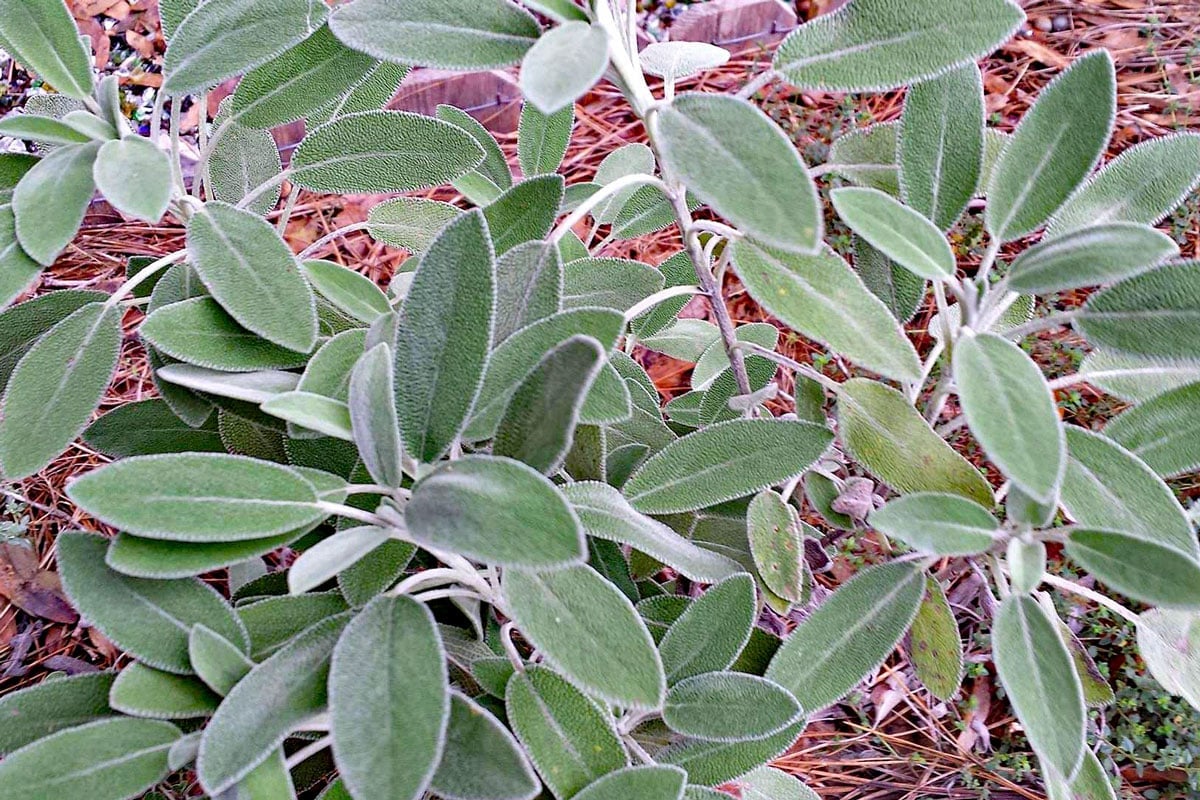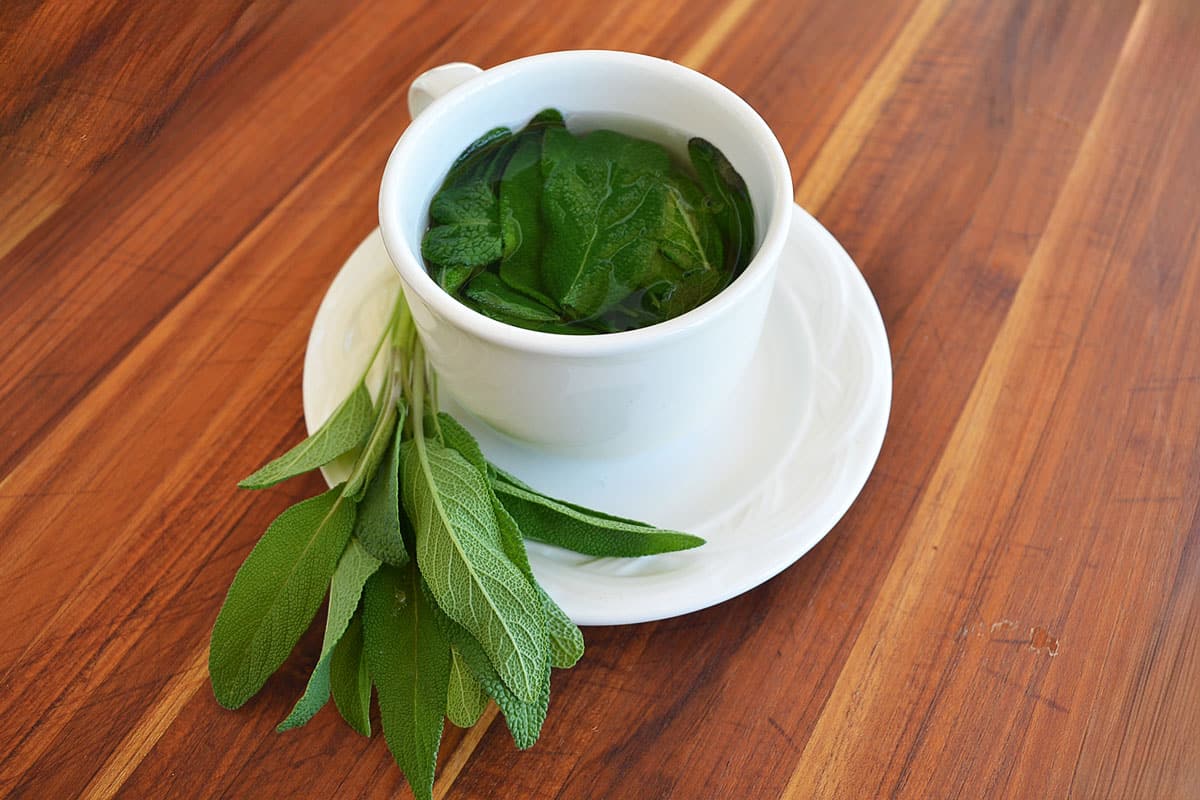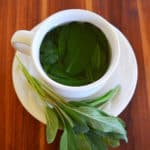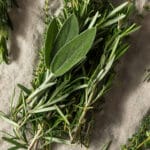Sage Benefits: Traditional Wisdom Backed by Modern Research
This post may contain affiliate links. Read my full disclosure here.
Sage (Salvia officinalis) has been used as a healing herb for thousands of years. Modern science is finally catching up to what traditional herbalists already knew—sage benefits more than your recipes. Its biologically active compounds boost memory and mood , and improve metabolic health and hormonal balance.
We’ll explore the effects of Salvia officinalis backed by modern research. Plus, we share how to use sage safely, and what to know about side effects, dosage, and interactions with medications.

Table of Contents
- What Makes Sage Such a Powerful Healing Herb?
- Sage May Improve Memory and Support Brain Health
- Sage Has Strong Anti-Inflammatory and Antioxidant Activity
- Sage May Help Support Healthy Blood Sugar Levels
- Sage for Menopause: Easing Hot Flashes and Night Sweats
- Sage for Digestion and Immune Support
- Sage Essential Oil: Potent, But Use With Care
- How to Use Sage: Teas, Tinctures, Culinary Use, and More
- Sage Benefits Go Far Beyond Flavor
What Makes Sage Such a Powerful Healing Herb?
Sage is rich in antioxidant compounds. These help the body defend itself against free radicals, unstable molecules that contribute to aging and chronic disease. One of its most notable components is rosmarinic acid, a compound also found in rosemary and oregano. Rosmarinic acid has well-documented anti-inflammatory and antioxidant properties, which help explain many of sage’s traditional uses.
Other biologically active compounds include flavonoids, phenolic acids, and essential oils. Sage contains thujone, a compound that can be toxic in very high amounts. Culinary sage and common herbal preparations contain small amounts that are generally safe for healthy adults when used appropriately.
Because of its diverse chemistry, research suggests that sage may help support several body systems. This makes it one of the more versatile herbal medicines you can grow at home.
Sage May Improve Memory and Support Brain Health
One of the most studied medicinal properties of sage is its potential cognitive benefits. Several small clinical trials have found that sage may help improve memory, alertness, and concentration.
Some studies examining the effect of sage on older adults suggest mild improvements in attention and working memory. Younger adults may experience enhanced mental clarity. These findings are promising and help validate sage’s long history as a memory-boosting herb.
Try: adding fresh sage leaves to meals, drinking sage tea, or diffusing small amounts of sage essential oil when studying or working.
Sage Has Strong Anti-Inflammatory and Antioxidant Activity
Chronic inflammation contributes to many modern health concerns, from joint discomfort to digestive issues. Sage’s high antioxidant content gives it powerful anti-inflammatory potential.
Studies show that rosmarinic acid, flavonoids, and other plant compounds may help reduce inflammation and oxidative damage. These protective effects extend throughout the body, including:
- The cardiovascular system
- The digestive tract
- The immune system
- Joint and connective tissues
Sage appears frequently in traditional remedies for sore throats, respiratory irritation, minor infections, and digestive discomfort.
Sage May Help Support Healthy Blood Sugar Levels
One area of growing interest is sage’s effect on metabolism. Early research suggests that sage extracts may help support normal blood sugar levels. This makes it potentially useful for people concerned about insulin resistance or early metabolic imbalance.
Some small studies indicate that sage may help the body manage glucose more efficiently. These findings hint at why sage has been used historically for metabolic and digestive support.
If you are taking diabetes medications or monitoring glucose, check with a healthcare provider before adding sage supplements.
Sage for Menopause: Easing Hot Flashes and Night Sweats
Traditionally, sage tea has been used to help reduce excessive sweating. Modern research is now exploring its potential role in reducing menopausal symptoms, including hot flashes and night sweats.
Sage may help with menopausal discomfort because of its influence on neurotransmitters and its mild estrogen-like activity. Several herbal blends for menopause include sage because of its reputation for helping balance temperature regulation and perspiration.
Women experiencing perimenopause or menopause may find relief with daily sage tea or standardized sage extract. Everyone is unique, so effects may vary.
Sage for Digestion and Immune Support
Sage’s aromatic compounds have long been used to calm digestive upset, especially gas, bloating, and mild cramping. Sage tea is a traditional remedy after heavy meals and may help stimulate digestive enzymes.
It also has natural antimicrobial properties. Sage extracts have been shown to inhibit certain bacteria and fungi in laboratory settings. This could be why it has a reputation for helping soothe sore throats, coughs, and minor oral infections.
In addition to tea, sage gargles and throat sprays are common herbal preparations that take advantage of these properties.
Sage Essential Oil: Potent, But Use With Care
Sage essential oil is much more concentrated than culinary sage or herbal preparations. It contains higher levels of active compounds, including thujone.
Potential benefits of sage essential oil include:
- Mental alertness
- Antimicrobial effects
- Topical warming or soothing when diluted
Always use sage essential oil cautiously. Because sage contains thujone, excessive or undiluted use can lead to toxicity. Don’t consume essential oils, and dilute them properly before applying to the skin.
Pregnant women, children, and individuals with seizure disorders should avoid sage essential oil unless directed by a trained practitioner.
Would you like to save this?
How to Use Sage: Teas, Tinctures, Culinary Use, and More
Sage is a flexible herb that can be used in several forms depending on your needs. Opt for common sage (Salvia officinalis) for cooking, and save the purple, tricolor, or golden sages for other uses. The brighter varieties contain more camphor, which can ruin a recipe.
Fresh or Dried Sage Leaves
Culinary sage offers mild benefits through routine use. Add it to poultry dishes, roasts, soups, sauces, or compound butters.
Sage Tea
Made from dried or fresh leaves, sage tea is excellent for digestion, sore throats, sweating, and mild mood support. Steep 1–2 teaspoons of dried sage in hot water for 5–10 minutes.

Sage Tinctures and Extracts
Sage extracts provide more concentrated levels of active compounds. Use extracts for cognitive support, menopausal symptoms, and metabolic balance.
Sage Gargles
For sore throats, steep a strong sage tea, let it cool, and use it as a gargle several times a day.
Topical Preparations
Use infused oils or diluted essential oils on the skin for warming, antimicrobial, or aromatherapy purposes.
Potential Side Effects and Safety Considerations
While sage is safe for culinary use and moderate tea consumption, concentrated forms require more caution.
Side Effects May Include:
- Nausea when taken in excess
- Rapid heartbeat (rare, often linked to high-thujone extracts)
- Skin irritation from essential oil
- Headaches or dizziness in sensitive individuals
Talk with a healthcare provider if you are on medications for diabetes, seizures, or mood disorders before using concentrated sage preparations.
Who Should Avoid Sage?
- Pregnant or breastfeeding women should avoid medicinal doses of sage because of thujone.
- Individuals with seizure disorders should not use sage essential oil.
- Anyone taking diabetes medications should monitor blood sugar if using sage extracts.
Moderation is key—culinary sage and occasional tea are considered safe for most people.
Growing and Harvesting Sage at Home
One of the advantages of sage is that it’s incredibly easy to grow, even for beginners. Sage prefers full sun, well-drained soil, and moderate watering. Once established, sage plants can live for several years. We have a large plant that lives in the corner of our greenhouse.

To harvest, clip fresh sage leaves as needed or gather larger quantities in late summer before flowering. Dry the leaves in small bundles or on screens in a well-ventilated area.
Store dried sage in glass jars away from heat and light for the best flavor and potency.
Sage Benefits Go Far Beyond Flavor
Sage has earned its place as one of the most respected herbal medicines in both traditional and modern practice. Its biologically active compounds—especially rosmarinic acid—offer antioxidant, antimicrobial, and anti-inflammatory support.
Used mindfully and in moderation, sage can be a valuable addition to your natural wellness routine. It’s also a beautiful, functional herb for any home garden.

This article is written by Laurie Neverman. Laurie is a lifelong learner with a passion for natural remedies and holistic healing. She’s successfully improved her eyesight and cleared her psoriasis.
Originally posted in 2015, last updated in 2025




In our gardens in Catalunya, Spain we have temperatures from – 10C to 38C sometimes 40C. We never water them and they grow fine all year. We’ve had them about 15 years.
They’re really easy to grow cuttings from. I take mine in November and simply put them in any soil. A bit of grit on top and leave them outside
Here in Wisconsin, we get temps far lower than that (-20 to -30C), so while my greenhouse sage has survived for several years, my garden sage normally does not. I’m glad your plants have grown so well.
Hi I came across your site when I was researching the benefits of sage. You say sage is an annual but I have one that has grown for years without dying. I live 30 miles north east of Wellington, New Zealand. We have a cool temperate climate. One thing about my sage is that it grows where a feijoa used to grow. Feijoas make soil very fertile. My sage also grows with some thyme and marjoram.
Strangely enough, sage is one of those plants that may survive as a hardy perennial in temperate climates, but must be grown as an annual in hot climates because it doesn’t tolerate extreme heat and humidity. I’ve had plants survive a number of years here in my Wisconsin garden, but I’m sure Amber gets a little too warm in her south Carolina garden for plants to survive from year to year.
Great post! By the way I think you mean folate, folic acid is synthetic folate which is harmful to many people. Now I am going to plant sage!
Thank you! Correcting that right now.
Dried sage leaves are delicious in hot tea. Just pick off the leaves of rinsed and blotted dry stems and spread out to air dry several days til shriveled. Store in air tight container. I love it with Earl Grey. Just put some into the pot with the tea and steep.
[WORDPRESS HASHCASH] The poster sent us ‘0 which is not a hashcash value.